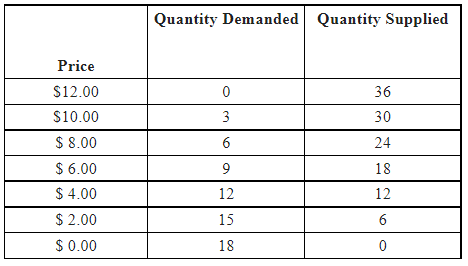Microeconomics Ch 5-8 Review
5.0(1)
Card Sorting
1/164
Earn XP
Description and Tags
Study Analytics
Name | Mastery | Learn | Test | Matching | Spaced |
|---|
No study sessions yet.
165 Terms
1
New cards
Suppose the price of a bag of frozen chicken nuggets decreases from $6.50 to $5.75 and, as a result, the quantity of bags demanded increases from 600 to 800. Using the midpoint method, the price elasticity of demand for frozen chicken nuggets in the given price range is
2.33
Change in price:
(5.75-6.5)/6.125=0.1224
Change in quantity demanded:
(800-600)/700=0.2857
0.1224/0.2857=2.33
Change in price:
(5.75-6.5)/6.125=0.1224
Change in quantity demanded:
(800-600)/700=0.2857
0.1224/0.2857=2.33
2
New cards
When demand is elastic, a decrease in price will cause
an increase in total revenue
3
New cards
Goods with many close substitutes tend to have
more elastic demands
4
New cards
Total revenue when the price is P2 is represented by the area(s)
A+B
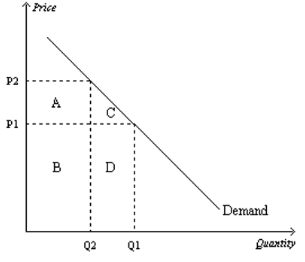
5
New cards
An increase in price causes an increase in total revenue when demand is
inelastic
6
New cards
Demand is inelastic if the price elasticity of demand is
less than 1
7
New cards
Total revenue will be at its largest value on a linear demand curve at the
midpoint of the curve
8
New cards
Demand is said to be inelastic if
the quantity demanded changes only slightly when the price of the good changes
9
New cards
As price falls from Pa to Pb, which demand curve represents the most elastic demand?
D1
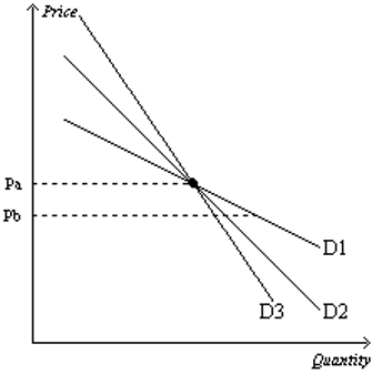
10
New cards
Total revenue when the price is P1 is represented by the area(s)
B+D
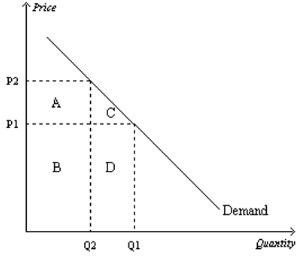
11
New cards
Demand is said to be unit elastic if quantity demanded
changes by the same percent as the price
12
New cards
Suppose demand is perfectly elastic, and the supply of the good in question decreases. As a result,
the equilibrium quantity decreases, and the equilibrium price is unchanged
13
New cards
When the price of chai tea lattés is $5, Maxine buys 20 per month. When the price is $4, she buys 30 per month.
elastic, and her demand curve would be relatively flat
14
New cards
As we move downward and to the right along a linear, downward-sloping demand curve,
slope remains constant but elasticity changes
15
New cards
When demand is unit elastic, price elasticity of demand equals
1, and total revenue does not change when price changes
16
New cards
Elasticity of demand is closely related to the slope of the demand curve. The more responsive buyers are to a change in price, the
flatter the demand curve will be
17
New cards
If rectangle D is larger than rectangle A, then
A. demand is elastic between prices P1 and P2
B. a decrease in price from P2 to P1 will cause an increase in total revenue
C. the magnitude of the percent change in price between P1 and P2 is smaller than the magnitude of the corresponding percent change in quantity demanded
D. All of the above are correct
A. demand is elastic between prices P1 and P2
B. a decrease in price from P2 to P1 will cause an increase in total revenue
C. the magnitude of the percent change in price between P1 and P2 is smaller than the magnitude of the corresponding percent change in quantity demanded
D. All of the above are correct
D
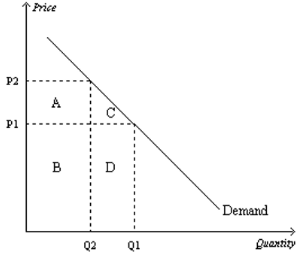
18
New cards
Between point A and point B, price elasticity of demand is equal to
1.5
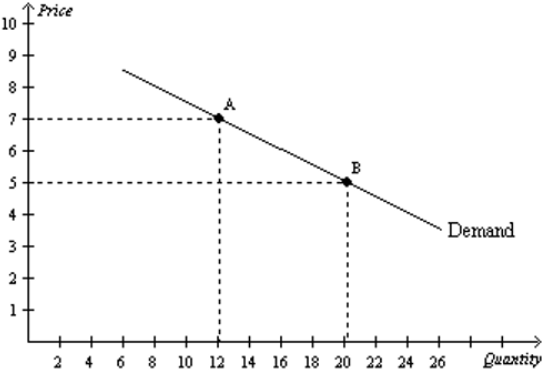
19
New cards
Suppose the point labeled B is the "halfway point" on the demand curve and it corresponds to a price of $5.00. Then, between prices of $4.99 and $5.01, the price elasticity of demand is
equal to 1

20
New cards
For a good that is a necessity, demand
tends to be inelastic
21
New cards
Which of the following is likely to have the most price inelastic demand?
salt
22
New cards
The demand for Godiva mint chocolates is likely quite elastic because
A. there are many close substitutes
B. the market is narrowly defined
C. All of the above are correct
D. this particular type of chocolate is viewed as a luxury by many chocolate lovers
A. there are many close substitutes
B. the market is narrowly defined
C. All of the above are correct
D. this particular type of chocolate is viewed as a luxury by many chocolate lovers
C
23
New cards
When demand is inelastic, a decrease in price will cause
a decrease in total revenue
24
New cards
For prices below $5, demand is price
inelastic, and raising price will increase total revenue
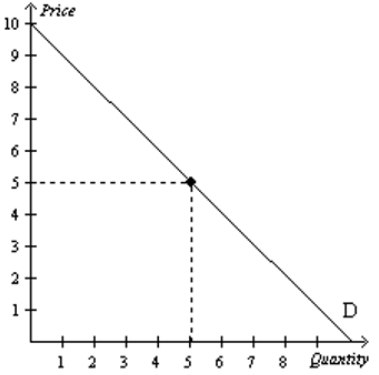
25
New cards
Using the midpoint method, the price elasticity of demand for a good is computed to be approximately 2. Which of the following events is consistent with a 0.1 percent increase in the price of the good?
The quantity of the good demanded decreases by 0.2 percent
?/0.1=2
?=2*0.1
?=0.2
?/0.1=2
?=2*0.1
?=0.2
26
New cards
Suppose that Janet likes Sprite so much that she consumes one can every day. Although she enjoys gourmet cheese, she consumes it sporadically. If the price of Sprite rises, Jane decreases her consumption by only a very small amount. But if the price of gourmet cheese rises, Jane decreases her consumption by a lot. These examples illustrate the importance of
a necessity versus a luxury in determining the price elasticity of demand
27
New cards
For a good that is a luxury, demand
tends to be elastic
28
New cards
For prices above $5, demand is price
elastic, and lowering price will increase total revenue
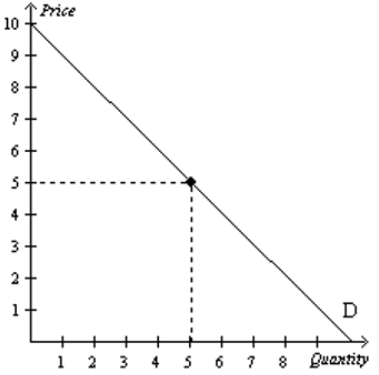
29
New cards
The price elasticity of demand for bread
A. is computed as the percentage change in quantity demanded of bread divided by the percentage change in price of bread
B. depends, in part, on the availability of close substitutes for bread
C. reflects the many economic, social, and psychological forces that influence consumers' tastes for bread
D. All of the above are correct.
A. is computed as the percentage change in quantity demanded of bread divided by the percentage change in price of bread
B. depends, in part, on the availability of close substitutes for bread
C. reflects the many economic, social, and psychological forces that influence consumers' tastes for bread
D. All of the above are correct.
D
30
New cards
When the price of a good is $5, the quantity demanded is 100 units per month; when the price is $7, the quantity demanded is 80 units per month. Using the midpoint method, the price elasticity of demand is about
0.67
Change in price:
(7-5)/6=0.3333
Change in quantity demanded:
(80-100)/90=0.2222
0.2222/0.3333=0.67
Change in price:
(7-5)/6=0.3333
Change in quantity demanded:
(80-100)/90=0.2222
0.2222/0.3333=0.67
31
New cards
For prices below $8, demand is price
inelastic, and total revenue will rise as price rises
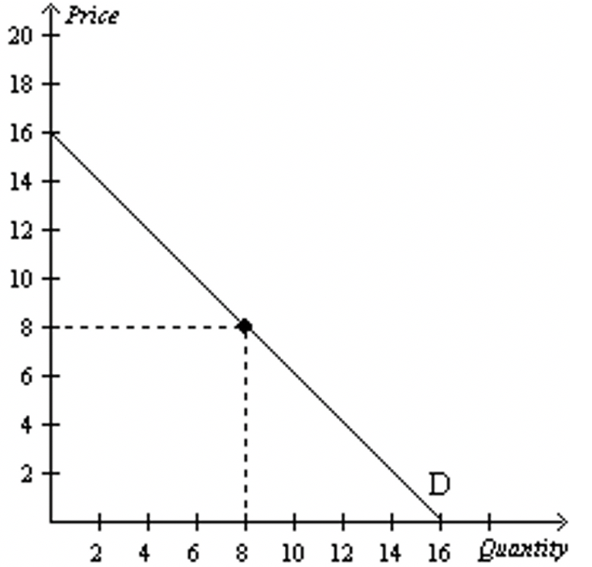
32
New cards
Which of the following could be the price elasticity of demand for a good for which a decrease in price would increase revenue?
4
33
New cards
If the price elasticity of demand for a good is 0.5, then a 5 percent increase in price results in a
2.5 percent decrease in the quantity demanded
34
New cards
The demand for grape flavored Hubba Bubba bubble gum is likely
elastic because there are many close substitutes for grape-flavored Hubba Bubba
35
New cards
If the price elasticity of demand for a good is 2.0, then a 10 percent increase in price results in a
20 percent decrease in the quantity demanded
36
New cards
Which of the following could be the price elasticity of demand for a good for which an increase in price would decrease revenue?
2.6
37
New cards
Elasticity is
a measure of how much buyers and sellers respond to changes in market conditions
38
New cards
Which of the following is likely to have the most price elastic demand?
diamond earrings
39
New cards
For a particular good, a 2 percent increase in price causes a 12 percent decrease in quantity demanded. Which of the following statements is most likely applicable to this good?
The good is a luxury
40
New cards
There are very few, if any, good substitutes for motor oil. Therefore, the
demand for motor oil would tend to be inelastic
41
New cards
When consumers face rising gasoline prices, they typically
reduce their quantity demanded more in the long run than in the short run
42
New cards
For prices above $8, demand is price
elastic, and total revenue will fall as price rises
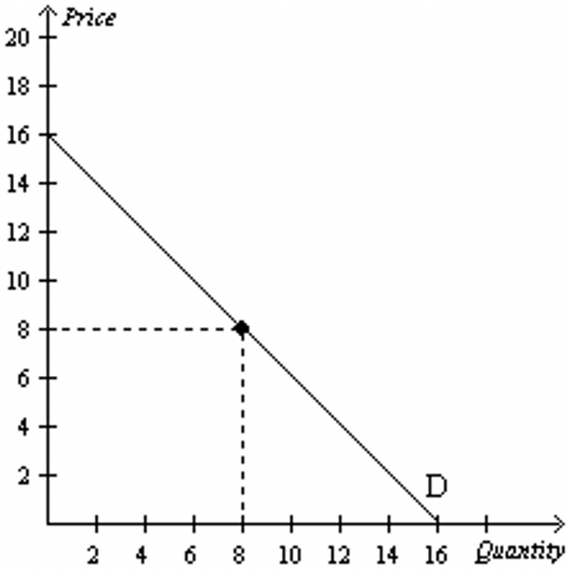
43
New cards
Which of the following could be the price elasticity of demand for a good for which an increase in price would increase revenue?
0.3
44
New cards
When a binding price floor is imposed on a market to benefit sellers,
some sellers will not be able to sell any amount of the good.
45
New cards
If the government levies a $500 tax per car on sellers of cars, then the price received by sellers of cars would
decrease by less than $500.
46
New cards
If the government removes a $2 tax on buyers of cigars and imposes the same $2 tax on sellers of cigars, then the price paid by buyers will
not change, and the price received by sellers will not change.
47
New cards
The vertical distance between points A and B represents the tax in the market. The amount of the tax per unit is
$14
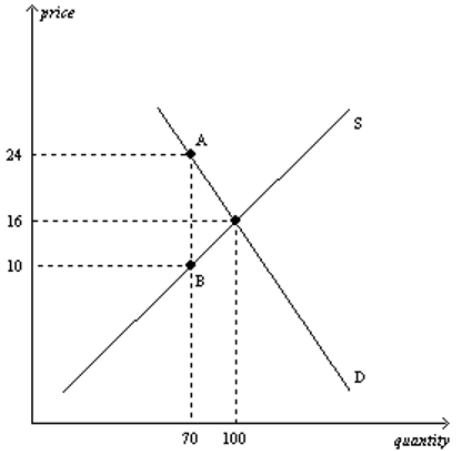
48
New cards
In response to a shortage caused by the imposition of a binding price ceiling on a market, price will no longer
A) be the mechanism that rations scarce resources.
B) long lines of buyers may develop.
C) sellers could ration the good or service according to their own personal biases.
D) All of the above are correct.
A) be the mechanism that rations scarce resources.
B) long lines of buyers may develop.
C) sellers could ration the good or service according to their own personal biases.
D) All of the above are correct.
D) All of the above are correct.
49
New cards
Price controls
can generate inequities of their own.
50
New cards
The price ceiling
causes a shortage of 85 units.
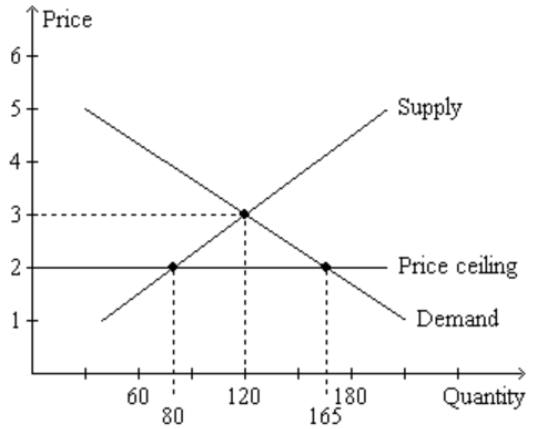
51
New cards
A government imposed price of $24 in this market is an example of a
binding price floor that creates a surplus.
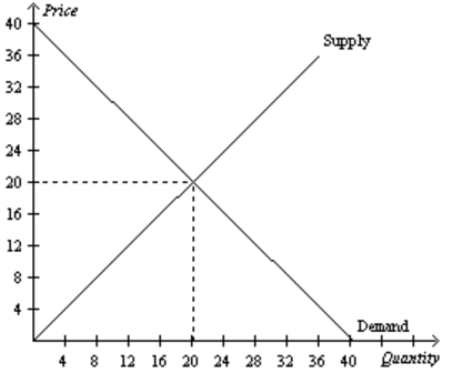
52
New cards
A government-imposed price floor of $12 in this market results in
a surplus of 4 units.
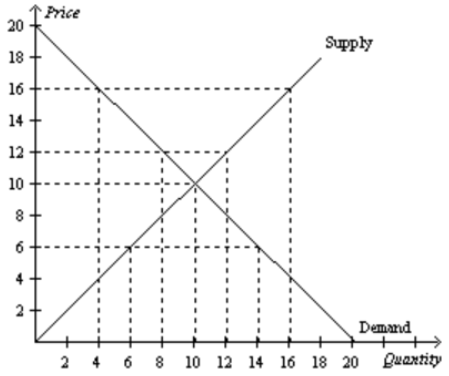
53
New cards
Price controls are usually enacted
when policymakers believe that the market price of a good or service is unfair to buyers or sellers.
54
New cards
When a tax is placed on the sellers of a product, buyers pay
more, and sellers receive less than they did before the tax.
55
New cards
The vertical distance between points A and B represents the tax in the market. The effective price that sellers receive after the tax is imposed is
$10
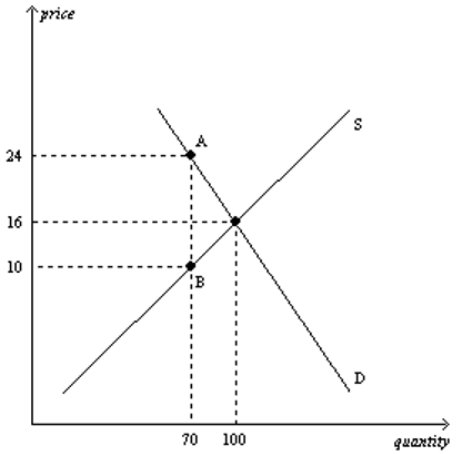
56
New cards
Suppose a tax of $2 per unit is imposed on this market. How much will sellers receive per unit after the tax is imposed?
between $3 and $5
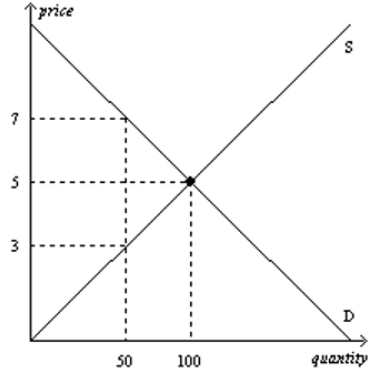
57
New cards
Which of the following is not correct?
Taxes levied on sellers and taxes levied on buyers are not equivalent.
58
New cards
Which of the following statements is not correct?
When the price is $6, there is a surplus of 8 units.
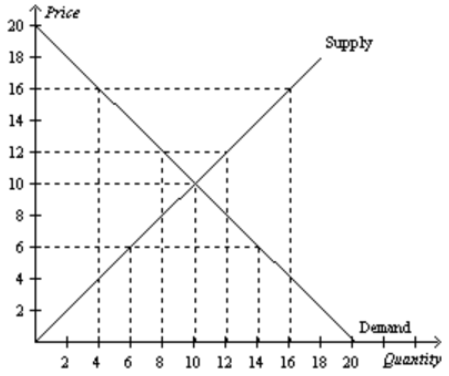
59
New cards
When a tax is levied on buyers of tea,
buyers of tea and sellers of tea both are made worse off.
60
New cards
The price ceiling shown above
creates a shortage.

61
New cards
A binding price ceiling is shown in
panel (b) only

62
New cards
If the government wants to reduce the burning of fossil fuels, it should impose a tax on
either buyers or sellers of gasoline.
63
New cards
A government-imposed price of $6 in this market is an example of a
binding price ceiling that creates a shortage.
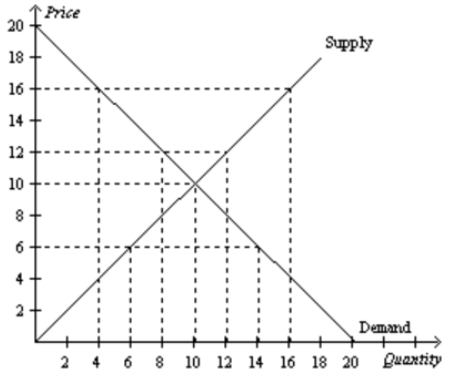
64
New cards
The vertical distance between points A and B represents the tax in the market. The per-unit burden of the tax on buyers is
$8
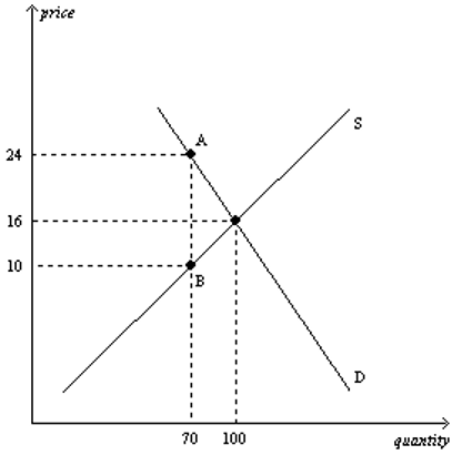
65
New cards
Suppose a tax of $2 per unit is imposed on this market. Which of the following is correct?
One-half of the burden of the tax will fall on buyers, and one-half of the burden of the tax will fall on sellers.
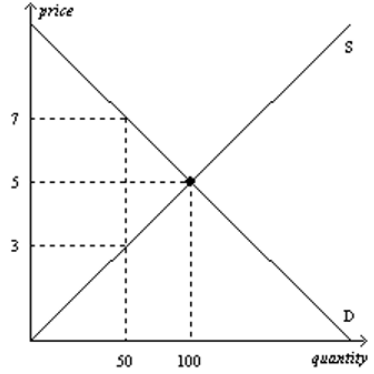
66
New cards
The imposition of a binding price floor on a market
causes quantity demanded to be less than quantity supplied.
67
New cards
Suppose a tax of $2 per unit is imposed on this market. What will be the new equilibrium quantity in this market?
between 50 units and 100 units.
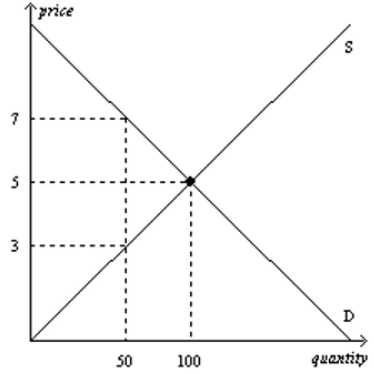
68
New cards
When a tax is placed on the buyers of a product, buyers pay
more and sellers receive less than they did before the tax.
69
New cards
When a binding price floor is imposed on a market,
price no longer serves as a rationing device.
70
New cards
A price floor is binding when it is set
above the equilibrium price, causing a surplus.
71
New cards
A price ceiling is
a legal maximum on the price at which a good can be sold.
72
New cards
Under rent control, tenants can expect
lower rent and lower quality housing.
73
New cards
If the horizontal line on the graph represents a price floor, then the price floor is
not binding, and there will be no surplus or shortage of the good.
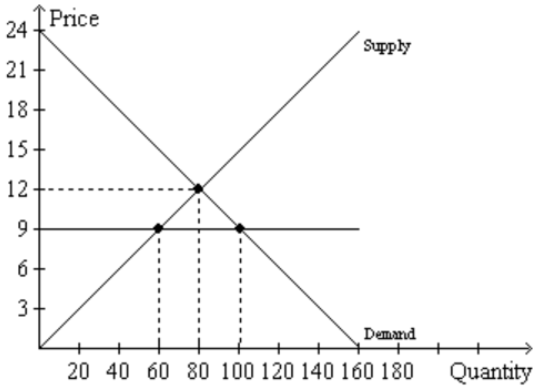
74
New cards
A $2.00 tax levied on the sellers of birdhouses will shift the supply curve
upward by exactly $2.00.
75
New cards
A nonbinding price floor is shown in
panel (a) only

76
New cards
If the government removes a binding price floor from a market, then the price paid by buyers will
decrease, and the quantity sold in the market will increase.
77
New cards
The price ceiling
makes it necessary for sellers to ration the good.
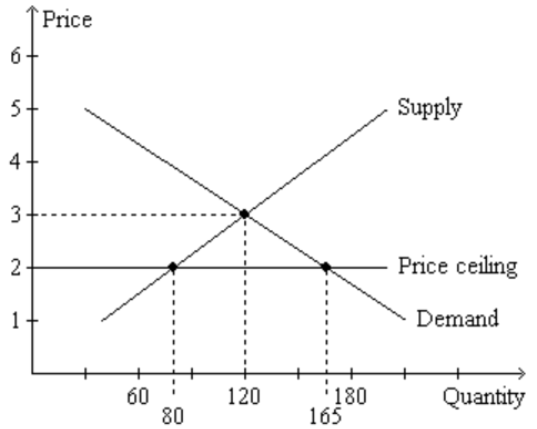
78
New cards
The vertical distance between points A and B represents the tax in the market. The price that buyers pay after the tax is imposed is
$24
79
New cards
In a competitive market free of government regulation,
price adjusts until quantity demanded equals quantity supplied.
80
New cards
Suppose a tax of $2 per unit is imposed on this market. How much will buyers pay per unit after the tax is imposed?
between $5 and $7
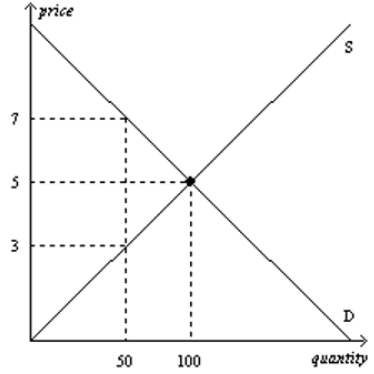
81
New cards
The vertical distance between points A and B represents the tax in the market. The per-unit burden of the tax on sellers.
$6
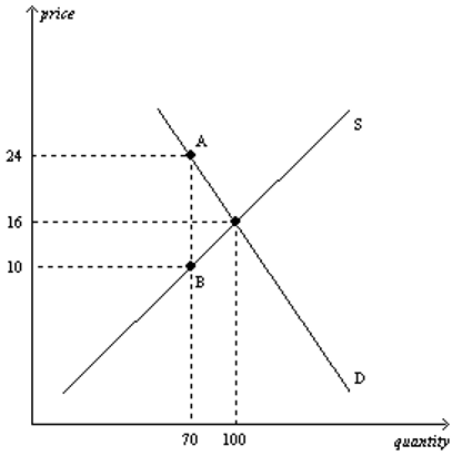
82
New cards
At the equilibrium price, consumer surplus is
$100
=20*10/2
=20*10/2

83
New cards
Suppose that Firms A and B each produce high-resolution computer monitors, but Firm A can do so at a lower cost. Cassie and David each want to purchase a high-resolution computer monitor, but David is willing to pay more than Cassie. Which of the following market outcomes is efficient?
Firm A produces a monitor that David buys.
84
New cards
If the current allocation of resources in the market for wallpaper is efficient, then it must be the case that
a. producer surplus equals consumer surplus in the market for wallpaper.
b. the market for wallpaper is in equilibrium.
c. on the last unit of wallpaper that was produced and sold, the value to buyers exceeded the cost to sellers.
d. all of the above
a. producer surplus equals consumer surplus in the market for wallpaper.
b. the market for wallpaper is in equilibrium.
c. on the last unit of wallpaper that was produced and sold, the value to buyers exceeded the cost to sellers.
d. all of the above
b. the market for wallpaper is in equilibrium.
85
New cards
Which area represents consumer surplus at a price of P1?
BDF

86
New cards
For quantities less than M, the value to the marginal buyer is
greater than the cost to the marginal seller, so increasing the quantity increases total surplus.
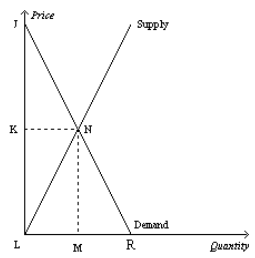
87
New cards
For each of three potential buyers of oranges, the table displays the willingness to pay for the first three oranges of the day. Assume Allison, Bob, and Charisse are the only three buyers of oranges, and only three oranges can be supplied per day. If the market price of an orange is $0.65, then consumer surplus amounts to
$3.60
=(2-0.65)+(1.5-0.65)+(0.75-0.65)+(1.5-0.65)+(1-0.65)+(0.75-0.65)
=(2-0.65)+(1.5-0.65)+(0.75-0.65)+(1.5-0.65)+(1-0.65)+(0.75-0.65)

88
New cards
Which area represents consumer surplus at a price of P2?
AFG
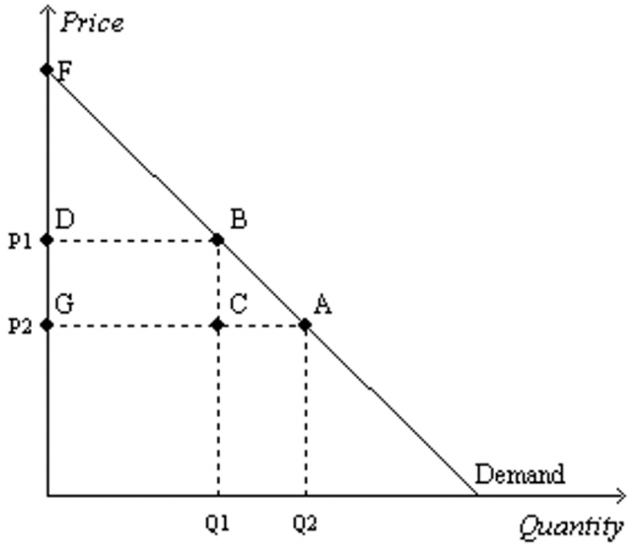
89
New cards
If the government imposes a price floor of $110 in this market, then consumer surplus will decrease by
$600
=(10*40/2)+(10*40)
=(10*40/2)+(10*40)
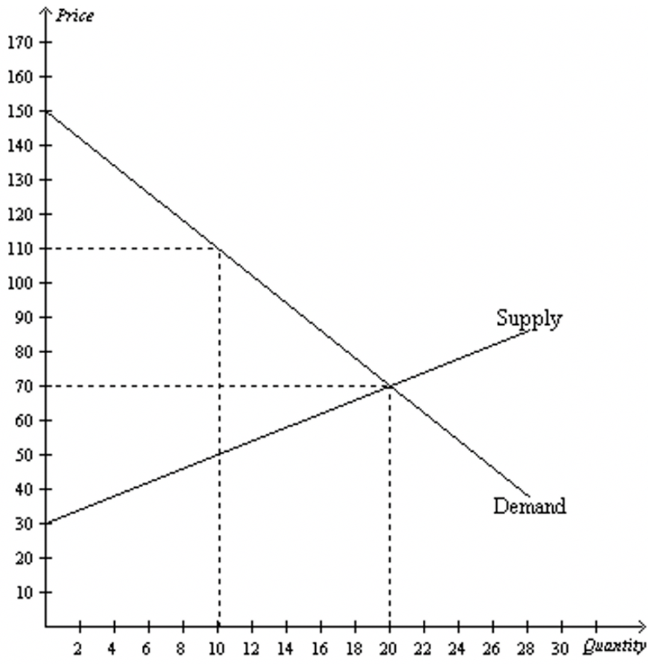
90
New cards
Bob purchases a book for $6, and his consumer surplus is $2. How much is Bob willing to pay for the book?
$8
=price + CS = 6+2
=price + CS = 6+2
91
New cards
Steak and chicken are substitutes. A sharp reduction in the supply of steak would
decrease consumer surplus in the market for steak and increase producer surplus in the market for chicken.
92
New cards
Both the demand curve and the supply curve are straight lines. At equilibrium, producer surplus is
$24
=12*4/2
=12*4/2
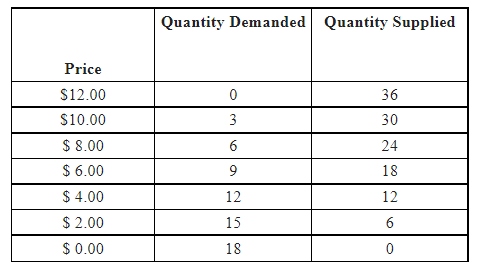
93
New cards
At the equilibrium price, total surplus is
$250
=(30*10/2)+(20*10/2)
=(30*10/2)+(20*10/2)
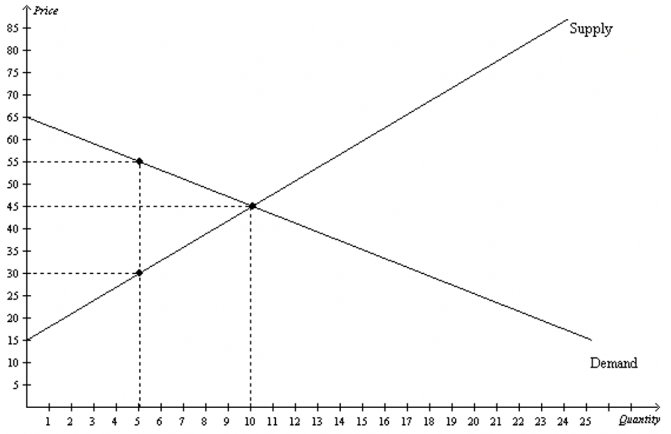
94
New cards
All else equal, what happens to consumer surplus if the price of a good increases?
Consumer surplus decreases
95
New cards
At the equilibrium price, consumer surplus is
$800
=80*20/2
=80*20/2

96
New cards
When the price is P1, consumer surplus is
A+B+C
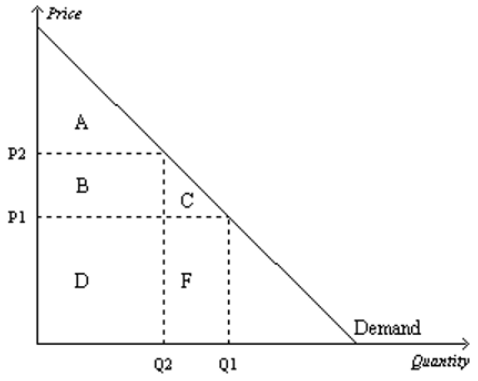
97
New cards
For each of three potential buyers of oranges, the table displays the willingness to pay for the first three oranges of the day. Assume Allison, Bob, and Charisse are the only three buyers of oranges, and only three oranges can be supplied per day. If the market price of an orange is $0.40, then
7 oranges are demanded per day, and consumer surplus amounts to $5.30
7 people have a WTP higher than $0.40, find CS for those 7 people only
7 people have a WTP higher than $0.40, find CS for those 7 people only

98
New cards
For each of three potential buyers of apples, the table displays the willingness to pay for the first three apples of the day. Assume Xavier, Yadier, and Zavi are the only three buyers of apples, and only three apples can be supplied per day. If the market price of an apple increases from $1.40 to $1.60, then consumer surplus
decreases by $0.45
=CS at $1.40 - CS at $1.60
=0.60-0.15
=CS at $1.40 - CS at $1.60
=0.60-0.15

99
New cards
In a market, the marginal buyer is the buyer
who would be the first to leave the market if the price were any higher.
100
New cards
Both the demand curve and the supply curve are straight lines. At equilibrium, total surplus is
$72
